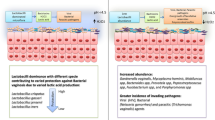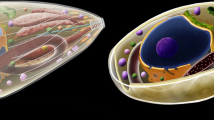Abstract
The parasite Trichomonas vaginalis causes one of the most common non-viral sexually transmitted infections in humans. The coexistence of different sexually transmitted diseases in the same individual is very common, such as vaginal infections by T. vaginalis in association with Mycoplasma fermentans or Mycoplasma hominis. However, the consequences and behavior of mycoplasma during trichomonad infections are virtually unknown. This study was undertaken to elucidate whether mycoplasmas enter and leave trichomonad cells and if so how. M. hominis was analyzed in different trichomonad isolates and the process of internalization and the pathway within the parasite was studied. Parasites naturally and experimentally infected with mycoplasmas were used and transmission electron microscopy, cytochemistry and PCR analyses were performed. The results show that: (1) M. hominis enters T. vaginalis cells by endocytosis; (2) some mycoplasmas use a terminal polar tip as anchor to the trichomonad plasma membrane; (3) some trichomonad isolates are able to digest mycoplasmas, mainly when the trichomonads are experimentally infected; (4) some fresh virulent isolates are able to maintain mycoplasmas as cohabitants in the cell’s interior; (5) some mycoplasmas are able to escape from the vacuole to the trichomonad cytosol, and trichomonad plasma membrane budding suggested that mycoplasmas could leave the parasite cell.











Similar content being viewed by others
References
Affonso A, Benchimol M, Ribeiro KC, Lins U, De Souza W (1994) Further studies on the endocytic activity of Tritrichomonas foetus. Parasitol Res 80:403–413
Alderete JF (1999) Iron modulates phenotypic variation and phosphorylation of P270 in double-stranded RNA virus-infected Trichomonas vaginalis. Infect Immun 67:4298–4302
Baker J, Brown MRW (1994) Trojan horses of the microbial world: protozoa and the survival of bacterial pathogens in the environment. Microbiology 140:1253–1259
Baseman JB, Lange M, Criscimagna NL, Giron JA, Thomas CA (1995) Interplay between mycoplasmas and host target cells. Microb Pathog 19:105–116
Benchimol M, Batista C, De Souza W (1990) Fibronectin—and lamin—mediated endocytic activity in the parasitic protozoa Trichomonas vaginalis and Tritrichomonas foetus. J Submicrosc Cytol Pathol 22:39–45
Blanchard A, Yanez A, Dybvig K, Watson HL, Griffiths G, Cassell GH (1993) Evaluation of intraspecies genetic variation within the 16S rRNA gene of Mycoplasma hominis and detection by polymerase chain reaction. J Clin Microbiol 31:1358–1361
Cotch MF, Pastorek JG, Nugent RP, Hillier SL, Gibbs RS, Martin DH, Eschenbach DA, Edelman R, Carey JC, Regan JA, Krohn MA, Klebanoff MA, Rao AV, Rhoads GG (1997) Trichomonas vaginalis associated with low birth weight and preterm delivery. The vaginal infections and prematurity study group. Sex Transm Dis 24:353–360
Crouch ML, Benchimol M, Alderete JF (2001) Binding of fibronectin by Trichomonas vaginalis is influenced by iron and calcium. Microb Pathog 31:131–144
Dallo SF, Baseman JB (2000) Intracellular DNA replication and long-term survival of pathogenic mycoplasmas. Microb Pathog 29:301–309
Dessi D, Delogu G, Emonte E, Catania MR, Fiori PL, Rappelli P (2005) Long-term survival and intracellular replication of Mycoplasma hominis in Trichomonas vaginalis cells: potential role of the protozoon in transmitting bacterial infection. Infect Immun 73:1180–1186
Diamond LS (1957) The establishment of various trichomonads of animals and man in axenic cultures. J Parasitol 43:488–490
Draper D, Donohoe W, Mortimeer L, Heine RP (1998) Cystein proteases of Trichomonas vaginalis degrade secretory leucocyte protease inhibitor. J Infect Dis 178:815–819
Dussurget O, Roullaand-Dussoix D (1994) Rapid, sensitive PCR-based detection of Mycoplasmas in simulated samples of animal sera. Appl Environ Microbiol 60:953–959
Franzoso G, Dimitrov DS, Blumenthal R, Barile MF, Rottern S (1992) Fusion of Mycoplasma fermentans strain incognitos with T-lymphocytes. FEBS 303:251–254
Germain M, Krohn MA, Hillier SL, Eschenbach DA (1994) Genital flora in pregnancy and its association with intrauterine growth retardation. J Clin Microbiol 32:2162–2168
Gilbert RO, Elia G, Beach DH, Klaessig S, Sing BN (2000) Cytopathogenic effects of Trichomonas vaginalis on human vaginal epithelial cells cultured in vitro. Infect Immun 68:4200–4206
Goldstein F, Goldman MB, Cramer DW (1993) Relation of tubal infertility to a story of sexually transmitted diseases. Am J Epidemiol 137:577–584
Gram I, Macaluso M, Churchill J, Stalsberg H (1992) Tritrichomonas vaginalis (TV) and human papillomavirus (HPV) infection and the incidence of cervical intraepithelial neoplasia (CIN) grade III. Cancer Causes Control 3:231–236
Hayes SF, Burgdorfer W (1982) Reactivation of Rickettsia rickettsii in Dermacentor andersoni ticks: an ultrastructural analysis. Infect Immun 37:770–785
Kharsany AB, Hoosen AA, Moodley J, Bagaratee J, Gouws E (1993) The association between sexually transmitted pathogens and cervical intra-epithelial neoplasia in a developing community. Genitourin Med 69:357–360
Kikkawa S, Matsumoto M, Sasaki T, Nishiguchi M, Tanaka K, Toyoshima K, Seya T (2000) Complement activation in Mycoplasma fermentans—induced mycoplasma clearance from infected cells: probing of the organism with monoclonal antibodies against M161Ag. Infect Immun 68:1672–1680
Marshall A, Afshar B, Pacy J, Pitcher D, Miles R (1998) Intracellular location of mycoplasmas. Microbiology 144:3240–3241
Minkoff H, Grunebaum AN, Schwarz RH, Feldman J, Cummings MC, Clark WL, Pringle G, McCormack MW (1984) Risk factor for prematurity and premature rupture of membranes: a prospective study of the vaginal flora in pregnancy. Am J Obstet Gynecol 150:965–972
Moulder JW (1985) Comparative biology of intracellular parasitism. Microbiol Rev 49:298–337
Nielsen MH (1975) The ultrastructure of Trichomonas vaginalis Donnè before and after transfer from vaginal secretion to diamonds medium. Acta Pathol Microbiol Scand 83:381–389
Pietersen R, Thilo L, Chastellier C (2004) Mycobacterium tuberculosis and Mycobacterium avium modify the composition of the phagosomal membrane in infected macrophages by selective depletion of the cell surface-derived glycoconjugates. Eur J Cell Biol 83:153–158
Pindak FF, Pindak MM, Hyde BM, Gardner WA Jr (1989) Acquisition and retention of viruses by Trichomonas vaginalis. Genitourin Med 65:366–371
Rappelli P, Addis MF, Carta F, Fiori PL (1998) Mycoplasma hominis parasitism of Trichomonas vaginalis. Lancet 352:1286
Rappelli P, Carta F, Delogu G, Addis MF, Dessi D, Cappuccinelli P, Fiori PL (2001) Mycoplasma hominis and Trichomonas vaginalis symbiosis: multiplicity of infection and transmissibility of M. hominis to human cells. Arch Microbiol 175:70–74
Razin S (1992) Mycoplasmas: molecular biology and pathogenesis Maniloff J et al (eds) ASM Press, Washington, pp 3–22
Razin S, Jacobs E (1992) Mycoplasma adhesion. J Gen Microbiol 138:407–422
Robinson IM, Karnovsky MJ (1983) Ultrastructural localization of several phosphatases with cerium. J Histochem Cytochem 31:1197–1208
Rodgerson EB (1972) Vulvovaginal papillomas and Trichomonas vaginalis. Obstet Gynecol 40:327–333
Rottem S, Naot Y (1998) Subversion and exploitation of host cells by mycoplasmas. Trends Microbiol 6:436–4440
Scholtyseck E, Teras J, Kaskova I, Sethi KK (1985) Electron microscope observation on the interaction of Mycoplasma fermentans with Trichomonas vaginalis. Z Parasitenkd 71:435–442
Sorvillo F, Kovacs A, Kerndt P, Stek A, Muderspach L, Sanchez-Keeland L (1998) Risk factors for trichomoniasis among women with human immunodeficiency virus (HIV) infection at a public clinic in Los Angeles County, California: implications for HIV prevention. Am J Trop Med Hyg 58:495–500
Street DA, Wells C, Taylor-Robinson D, Packers JP (1984) Interaction between Trichomonas vaginalis and other pathogenic microorganisms of the human genital tract. Br J Vener Dis 60:31–38
Tarshis M, Salman M, Tottem S (1993) Cholesterol is required for the fusion of single unilamellar vesicles with Mycoplasma capricolum. Biophys J 64:709–715
Taylor-Robinson D (1998) Mycoplasma hominis parasitism of Trichomonas vaginalis. Lancet 352:2022
Taylor-Robinson D, Davies HA, Sarathchandra P, Furr PM (1991) Intracellular location of mycoplasmas in cultured cells demonstrated by immunocytochemistry and electron microscopy. Int J Exp Pathol 72:705–714
Zhang Z, Begg CB (1994) Is Trichomonas vaginalis a cause of cervical neoplasma? Results from a combined analysis of 24 studies. Int J Epidemiol 23:682–690
van der Schee C, Sluiters HJF, van der Meijden WI, van Beek P, Peerbooms P, Verbrugh H, van Belkum A (2001) Host and pathogen interaction during vaginal infection by Trichomonas vaginalis and Mycoplasma hominis or Ureaplasma urealyticum. J Microbiol Meth 45:61–67
Wang AL, Wang CC (1986) The dsRNA in T. vaginalis may originate from virus-like particles. Proc Natl Acad Sci 83:7956–7960
Wang CC, McClelland RS, Reilly M, Overbaugh J, Emery SR, Mandaliya K, Chohan B, Ndinya-Achola J, Bwayo J, Kreiss JK et al (2001) The effect of treatment of vaginal infections on shedding of human immunodeficiency virus type-1. J Infect Dis 183:1017–1022
Xiao JC, Xie LF, Fang SL, Gao MY, Zhu Y, Song LY, Zhong HM, Lun ZR (2006) Symbiosis of Mycoplasma hominis in Trichomonas vaginalis may link metronidazole resistance in vitro. Parasitol Res 100:123–130
Acknowledgments
The author would like to thank Dr. Misako Marsumoto (Osaka, Japan), for providing anti-mycoplasmas monoclonal antibodies. This work was supported by Conselho Nacional de Desenvolvimento Científico e Tecnológico (CNPq), Fundação Carlos Chagas Filho de Amparo a Pesquisa do Estado do Rio de Janeiro (FAPERJ), Programa de Núcleos de Excelência (PRONEX), CAPES (Coordenação de Aperfeiçoamento de Pessoal de Nível Superior), FENORTE (Fundação de Amparo a Pesquisa do Estado do Rio de Janeiro) and Associação Universitária Santa Úrsula (AUSU).
Author information
Authors and Affiliations
Corresponding author
Additional information
Communicated by Erko Stackebrandt.
Rights and permissions
About this article
Cite this article
Vancini, R.G., Benchimol, M. Entry and intracellular location of Mycoplasma hominis in Trichomonas vaginalis . Arch Microbiol 189, 7–18 (2008). https://doi.org/10.1007/s00203-007-0288-8
Received:
Revised:
Accepted:
Published:
Issue Date:
DOI: https://doi.org/10.1007/s00203-007-0288-8




